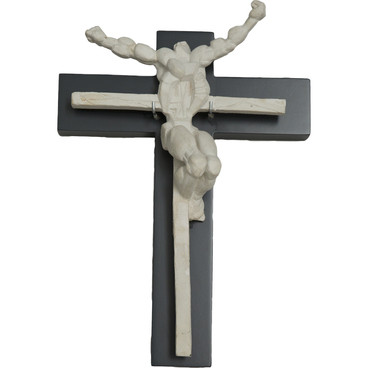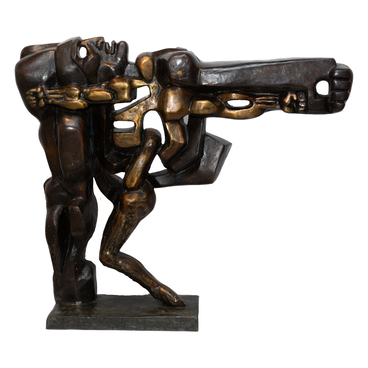A gypsum sculpture ‘Crucifixion’ is displayed in the showcase, it was created by Ernst Neizvestny in the 1960s – beginning of 1970s. This showpiece was presented to the Sverdlovsk Ethnography Museum by Vitaly Volovich, the People’s Artist of the Russian Federation, a friend of the sculptor.
Neizvestny’s views on religion and religious objects were extraordinary and special. The live plasticity of sculpture made it possible to convey the interrelationship of reality with the mystique – the vertical and the horizontal axis and dimensions. The Crucifixion embodies tension and rigidity of the material world, but then loses its restraining powers, giving way to spiritual values.
In ancient times crucifixion was practiced in Carthage, Babylonia, Palestine and Greece. In ancient Rome execution by crucifixion was very widespread, especially in the cases of crime against the State. Conspirators, rebels and traitors, as well as highway robbers, fugitive slaves and enemy prisoners of war used to be crucified in those times. The wooden crucifixion could be vertical or X-shaped. The cross for the crucifixion consisted of two elements – the vertical prop, dug into the ground and the removable horizontal plank, which the condemned person carried on his back to the place of the execution. Some crucifixion crosses had a slightly protruding ledge, serving as a rest for feet. Death on the cross was brutal and agonizing. It could take days for a man to die on the cross, depending on how fit he was, the method of crucifixion and the weather conditions. The crucified person did not lose consciousness and died of heart failure, heart attack, septicemia or asphyxia. History knows of multiple cases of solitary or mass crucifixions. For example, 6 thousand slaves, taken prisoner after crushing the Spartacus Revolt, were crucified alongside the Appian Way from Rome to Capua.
Jesus Christ and many of his followers were later executed the same way, Apostles Andrew and Paul among them. Due to this historical fact the cross became an eternal symbol of Christendom. Ernst Neizvestny interpreted this symbol in his own way, by revealing his own religious and philosophical understanding of the world to the modern generation.
Neizvestny’s views on religion and religious objects were extraordinary and special. The live plasticity of sculpture made it possible to convey the interrelationship of reality with the mystique – the vertical and the horizontal axis and dimensions. The Crucifixion embodies tension and rigidity of the material world, but then loses its restraining powers, giving way to spiritual values.
In ancient times crucifixion was practiced in Carthage, Babylonia, Palestine and Greece. In ancient Rome execution by crucifixion was very widespread, especially in the cases of crime against the State. Conspirators, rebels and traitors, as well as highway robbers, fugitive slaves and enemy prisoners of war used to be crucified in those times. The wooden crucifixion could be vertical or X-shaped. The cross for the crucifixion consisted of two elements – the vertical prop, dug into the ground and the removable horizontal plank, which the condemned person carried on his back to the place of the execution. Some crucifixion crosses had a slightly protruding ledge, serving as a rest for feet. Death on the cross was brutal and agonizing. It could take days for a man to die on the cross, depending on how fit he was, the method of crucifixion and the weather conditions. The crucified person did not lose consciousness and died of heart failure, heart attack, septicemia or asphyxia. History knows of multiple cases of solitary or mass crucifixions. For example, 6 thousand slaves, taken prisoner after crushing the Spartacus Revolt, were crucified alongside the Appian Way from Rome to Capua.
Jesus Christ and many of his followers were later executed the same way, Apostles Andrew and Paul among them. Due to this historical fact the cross became an eternal symbol of Christendom. Ernst Neizvestny interpreted this symbol in his own way, by revealing his own religious and philosophical understanding of the world to the modern generation.



